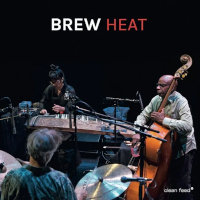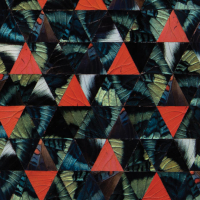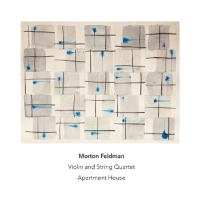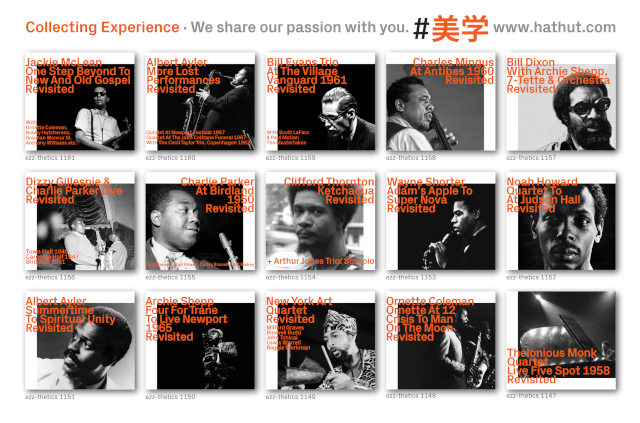Moment's Notice
Reviews of Recent Media
(continued)
Brew
Heat/Between Reflections
Clean Feed CF624CD
 Occasionally, an album title emblazons itself with energy forceful enough to encapsulate every sonic element it contains. Exuding unadulterated power and reflective division in equal measure, Heat/Between Reflections illuminates the points of intersection as fire, sacrificial or otherwise, penetrates and dissolves the boundaries separating shifting reality and infinite imagination. The phrase mirrors every tone, timbre, pulse, groove, and motive Gerry Hemingway, Miya Masaoka, and Reggie Workman harness on this double-disc document of a trio in multiple manifestations of flux.
Occasionally, an album title emblazons itself with energy forceful enough to encapsulate every sonic element it contains. Exuding unadulterated power and reflective division in equal measure, Heat/Between Reflections illuminates the points of intersection as fire, sacrificial or otherwise, penetrates and dissolves the boundaries separating shifting reality and infinite imagination. The phrase mirrors every tone, timbre, pulse, groove, and motive Gerry Hemingway, Miya Masaoka, and Reggie Workman harness on this double-disc document of a trio in multiple manifestations of flux.
Recorded two decades apart in studio and concert conditions, each disc is a snapshot in development of a trio exploring a series of areas. It is tempting to suggest that they are practicing a timbrally specialized version of what Schoenberg called developing variation. Much of this is down to the ensemble fluidity Brent Hayes Edwards describes in his excellent notes. Koto, bass, and percussion might be enough to blur those boundaries, but assimilation of sampling and processing eradicates them. As “Keffi’s Journey” catches fire, a fundamental groove doesn’t so much emerge as manifest in listener consciousness. It’s been there from the first notes, but the blooming, solidifying, and liquifying layers of acoustic and electronic sounds in various shades of counterpoint – bowed, plucked, and otherwise – vanguard its curves and syncopations, rendering it multicolored. Hemingway then slowly dissolves that underlying rhythmic complex, leaving a haze of vibrating air and reversed percussion floating in its wake. Material recorded at the Knitting Factory in 1999 presents similar modes of interaction, especially clear as the strings slowly expand “Serenade” from nascency, Hemingway supporting and enhancing rhythms as they pulse and counteract, passing through temporal concern rather than eschewing or being enslaved to it, a morphing concoction completely justifying the band’s name!
In 2019, the trio made another series of studio recordings that present, enigmatically, as simultaneously stripped down and expanded. The exquisite subtlety underlying Hemingway and Workman’s rhythmic and motivic exchanges on “Cricket’s Paradise” complement Masaoka’s intricate dan bau, though the whole emits a series of distances, of spaces between gestures akin to the meditator’s thoughts, surfacing only to vanish. Make no mistake though, because while much similar reflection is in evidence, the trio still cuts loose with the abandon of incendiary exploration, as when Masaoka raises the temperature in fits and starts with sweeping arpeggios on “Sun Shadows,” Hemingway and Workman augmenting and dispelling tonalities and momentary metric implications with equal rapidity.
What finally emerges is a trio of musicians encapsulating the depth of shared interstitial exploration. Yes, cultural signifiers abound, but juxtaposition and the space they entail are so much more fundamental to each syntactical statement. Each sound augurs micro and macrocosmic change, a nod toward motion that departs and predicts. Like the conversations of spirits in communion still grounded in reality, essences are elucidated while tropes are referenced only to be dispelled. Note, sound, and layer coalesce in context just as each piece forms the unity of each disc. The whole comprises dialogue of the highest order, but its vitality ensures that such lofty concerns defer to the power and excitement of each moment and the reflections brewing just beneath.
–Marc Medwin
Moniek Darge + Vanessa Rossetto
Dream Soundies
Erstwhile 096
 Walk along any bike path or stroll through any park, and it’s only a matter of time before the bicycle bells ring. The signal is both familiar and unsettling as it suspends time, only allowing for its reinstatement when normality emerges. Vanessa Rossetto and Moniek Darge’s new collaboration on Erstwhile, most intriguingly entitled Dream Soundies, will hold that sort of surprise for anyone momentarily bemused by that clear and present crystalline resonance, by the small skittering sound of a falling leaf or the sonic confluence of nature and industry now ineluctably shaping our environment, but its forms and structures penetrate far deeper than transient timbres into the realm of archetype in motion.
Walk along any bike path or stroll through any park, and it’s only a matter of time before the bicycle bells ring. The signal is both familiar and unsettling as it suspends time, only allowing for its reinstatement when normality emerges. Vanessa Rossetto and Moniek Darge’s new collaboration on Erstwhile, most intriguingly entitled Dream Soundies, will hold that sort of surprise for anyone momentarily bemused by that clear and present crystalline resonance, by the small skittering sound of a falling leaf or the sonic confluence of nature and industry now ineluctably shaping our environment, but its forms and structures penetrate far deeper than transient timbres into the realm of archetype in motion.
Of course, this project had at least part of its genesis in Darge’s long and absolutely stunning soundies series, documented on CD by the Kye label. For those unfamiliar, she’s an instrumentalist, a composer, and a collector of sounds, all of which makes her the ideal artistic partner for the similarly documentarian and aesthetically diverse Vanessa Rossetto. Both capture and present sounds as unit and in context, emphasizing an object’s individual characteristics while also drawing attention to its shape and depth. Both also revel in sonic disrepair, presenting a voice, a room or a street with grit and grime all over it. Underpinning these points of intersection, and maybe even more intriguing, is the way both artists confront and integrate the implications of what might be called “the score.” Beyond the complexities and nuances of their field recordings, there is often a musical or rhythmic layer underlying whatever sound is in focus. Frequently, and especially on Dream Soundies, those “musical” occurrences are instrumental, as they are on Rossetto’s recent masterpiece The Actress. That score may take on all manner of association, on its own terms and for the rest of the disc, like the music box peppering “Vignette” and which will return later in various manifestations. Even that immediately recognizable signifier is only one layer of a complex and shifting sonic palimpsest replete with vast planes of fluctuating drone dotted with nameless bits and bobs that take on a subconscious character of their own, the dream network of associations only fading as a palpable waking environment, complete with interrogative male voice, foregrounds itself. Yet, even that seeming stability is momentary, as what could be something as mundane as a stapler gathers immense proportion, finally setting a whirling series of rapid-fire repetitions in motion, stamping logic into the dust.
Similar juxtapositions of reality with whatever opposites might be evoked guides the rest of the disc. Time, space, and the sounds representing them are exposed, repeated, dissected, and hurled into various states of order and cacophony, all undergirded by the glacial slowness of area in exploration. It is as if the spaces between each object are highlighted in shades of various luminosities, like the evocative organ specters in ebbing and flowing states of cluster shadowing “Lincoln 1.”
Elsewhere in the same piece, what sounds like a toy emits animal sounds to the consternation of a very live dog. Elsewhere, a doggy toy spars with a similarly quickened canine, symptomatic of another series of relationships guiding the music along its whimsically circuitous path. There are giggle sticks rasping amidst sounds of the street in motion, the afore-mentioned music boxes and video games offsetting the sounds of children screaming, not to mention a seemingly non-sequitur rooster obviously plucked from an earlier soundie, perhaps meant to reinstate awareness? All of that enters into dialogue with sounds of heartstopping naturalness and detail, like beautifully and beinaurally recorded birds or a looped rhythmic dance demonstration, anchoring the otherwise shifting landscapes. Loops abound, and so many of the sound objects in interaction sway, wing, and slide past each other in cyclic dance.
When the various emotive states run their course, and when many of the sonic tropes have returned to conclude the evolving voyage, the impression remains of vastness and minutia in uneasy tandem, tiny objects vocalizing in the face of wind, water, and machine. The whimsicality of human utterance, improvised and occasionally imitating the animals elsewhere enshrined, is vanguarded only to become subservient to those larger entities all too ready to obliterate them but with whom they must find a way to coexist. A memorable siren sounds a dire but similarly ephemeral warning. Disparate motors vie with the sounds of washing in a kind of elemental counterpoint, and despite moments of levity, much of the music exudes a disorienting coexistence.
Most moving, though, is the conclusion of “Lincoln 1.” The mighty organ fades to impalpability, replaced by the sound of a child in song, stumbling, laughing, continuing. The little voice cracks with heart-breaking innocence until the peaceful ambiance of ocean waves overtakes it. There, in that calm space, the gently cyclic rise and fall of water lulls, envelops, soothes, and subdues, while barely audible beneath it all, beats a human heart. The sounds are as deep as they are unified, each repetition a place of inhabitation both unique and familiar. Here, all of the variously conflicting human and natural juxtapositions are resolved in a moment of staggering beauty needing no score. If the entire suite comprises a sonic feast of many courses, that brief sequence is a cadential transfiguration, bringing sound and cycle into momentary harmony.
–Marc Medwin
Kris Davis’ Diatom Ribbons
Live At The Village Vanguard
Pyroclastic PR 28/29
 If Diatom Ribbons was pianist Kris Davis’ breakthrough release, then the follow up Live At The Village Vanguard should firmly cement her position in the contemporary scene. Alongside Davis at the core of the unit remain the turntables and electronics of Val Jeanty and the drums of Terri Lyne Carrington. While variously augmented on their eponymous debut, for the weeklong 2022 residency at the storied venue from which this double album was culled, Davis expanded the band to a quintet by the addition of guitarist Julian Lage and bassist Trevor Dunn, who appear on all eleven tracks. The tilt towards a more conventional jazz instrumentation also coincides with a deceptively approachable ambience. However, Davis’ left field predilections mean that she’s never going to be content to settle into the mainstream, and her customary orneriness shows through in both her playing and her writing.
If Diatom Ribbons was pianist Kris Davis’ breakthrough release, then the follow up Live At The Village Vanguard should firmly cement her position in the contemporary scene. Alongside Davis at the core of the unit remain the turntables and electronics of Val Jeanty and the drums of Terri Lyne Carrington. While variously augmented on their eponymous debut, for the weeklong 2022 residency at the storied venue from which this double album was culled, Davis expanded the band to a quintet by the addition of guitarist Julian Lage and bassist Trevor Dunn, who appear on all eleven tracks. The tilt towards a more conventional jazz instrumentation also coincides with a deceptively approachable ambience. However, Davis’ left field predilections mean that she’s never going to be content to settle into the mainstream, and her customary orneriness shows through in both her playing and her writing.
At the keyboard Davis retains a cutting edge in which long flowing lines hint at minimalism on speed, blurred with the headlong rush and rhythmic virtuosity of a Bud Powell. Even on the cookers, her comping veers into something more angular and interactive, constantly questioning and probing. Lage allies the pure tone of a Wes Montgomery to singing licks and dexterous runs deployed with a sure sense of dynamics and phrasing. Although at times he can sound almost too elegant, in other moments he embraces the ambiguity which distinguished his two duets with Davis on her Duopoly set back in 2016. Dunn and Carrington form a hard-hitting team, one as likely to lay down a jazzy swing as a choppy pulse. Jeanty scratches at the turntables and colors with cross faded electronics, as well as speech samples. However, in the enlarged line up, she has fewer spaces to inhabit and as a result her contributions sometimes seem more adornment than integral.
At the heart of the program lies the three-part Bird Suite. “Kingfisher” kicks off with a bang, alternating between a relentlessly piledriving beat, which recalls the theme of the ‘60s Batman TV series, and various flavors of jerky atmospheric pulsation. Indeed it provokes Lage to as near as he gets to guitar heroics. “Bird Call Blues” employs two disparate ornithological sources, taking inspiration from both Olivier Messiaen’s “Petites esquisses d’oiseaux” and Charlie Parker’s “Blues For Alice.” It bursts with references, beginning with Jeanty’s stuttered treatments of the French composer’s voice, along with birdcalls Davis recorded near her New York home. She also weaves in Canadian pianist Paul Bley recounting why he had to move to NYC after he heard what Parker was doing, a feeling which must undoubtedly have resonance for his countrywoman Davis too. The unlikely mash up also provides a jaunty setting for a vibrant piano outing which ultimately stretches the form both harmonically and every other way. The final part, “Parasitic Hunter” offers a starker, knottier conclusion to the suite, featuring staccato unisons, a brief freak out, the interpolated voice of Karlheinz Stockhausen, and a hypnotic vamp, in which Carrington’s emphatic drum accents are the closest she comes to a solo.
Other pieces are somewhat more mysterious. The drifting textures – slow chiming guitar, beepy synth, and piano clunks – of “Nine Hats” in no way betray the parentage Davis sets out in the liners, one which draws on Eric Dolphy’s “Hat And Beard” (itself a tribute to Monk) and Conlon Nancarrow’s “Study No. 9 For Player Piano.” The lurching “VW” also features the voice of Sun Ra, subtly manipulated by Jeanty to fit with the disjointed rhythm. “Endless Columns” however, unites the enigmatic and the accessible, starting with an abstract exchange between Lage and Davis’ synth before later blossoming into a lyrical air studded by swaggering solos from both guitar and piano. As well as paying homage through Jeanty’s speech samples and a compositional process founded on specific antecedents, Davis also includes three covers, one in two very different takes. It’s often here that the axis of Carrington and Dunn takes wing. That’s especially the case on the two versions of “Dolores” by the drummer’s erstwhile employer Wayne Shorter, as they indulge in mercurial interplay on “Take 1,” initiating an earthy groove on “Take 2.” Their pounding skewed tattoo also creates a robust undercurrent to Ronald Shannon Jackson’s tumultuous “Alice In The Congo,” while Geri Allen’s “The Dancer” begins appropriately enough with Davis prepared piano plinks evoking a ballerina en pointe, before relaxing into a deeply satisfying lilt carried by Lage’s guitar. Over the 11 cuts, Davis once again demonstrates an inclusive vision in which she remains fiercely true to herself, yet vitally still open to others.
–John Sharpe
Morton Feldman
Violin And String Quartet
Another Timbre at212
 As the old and worn-out adage so succinctly states, everything is relative, this new Morton Feldman offering a case in point. Strangely, on first glance anyway, there’s a conspicuous absence of interview about Violin and String Quartet on Another Timbre’s site. Further reflection brings clarity. There’s a high degree of certainty that this two-disc set, comprising a massive late Feldman masterpiece performed by the more than estimable Apartment House, will sell itself, but there is also the music’s labyrinthine ineffability. Are the radical repositionings of form and formlessness that mark Feldman’s final achievements left to the poor listener’s discretion? So it seems until broken down to the gestural level, where everything becomes simple save the eternal bugbear of tonal reference, and really, isn’t the piece a miniature when compared to Feldman’s second quartet? So the contradictions proceed as hats are doffed toward the enigma that was and is Feldman’s music in general and final period in particular. For this review, I am using the uninterrupted two-hour plus master, and so all-time stamps will reflect that choice.
As the old and worn-out adage so succinctly states, everything is relative, this new Morton Feldman offering a case in point. Strangely, on first glance anyway, there’s a conspicuous absence of interview about Violin and String Quartet on Another Timbre’s site. Further reflection brings clarity. There’s a high degree of certainty that this two-disc set, comprising a massive late Feldman masterpiece performed by the more than estimable Apartment House, will sell itself, but there is also the music’s labyrinthine ineffability. Are the radical repositionings of form and formlessness that mark Feldman’s final achievements left to the poor listener’s discretion? So it seems until broken down to the gestural level, where everything becomes simple save the eternal bugbear of tonal reference, and really, isn’t the piece a miniature when compared to Feldman’s second quartet? So the contradictions proceed as hats are doffed toward the enigma that was and is Feldman’s music in general and final period in particular. For this review, I am using the uninterrupted two-hour plus master, and so all-time stamps will reflect that choice.
Contradictions ebb and flow in a fluid dance of shifting perceptions. Anyone remotely familiar with Feldman returns to him for what might be woefully understated as the sagely employment of constantly morphing repetition in the service of space and silence. The Beckett pauses with which the composer fills his scores occasionally spill over into interstices transcending momentary memory, becoming layered silences just as sonority fragments and reshapes itself into motive or line. These suspended instants impact all around them, as at 15:27, where the minute lengthening of pause into something more and less immediately tangible nudges what follows toward post-Webernian discontinuity, and yet, what concision! Each sonorous instant, whether sole aggregate or tonal complexes in groups, bristles with a certainty of execution in seeming contrast to the formal meandering that can afflict a first audition. Familiarity ensures that larger-scale reiterations, like the way the piece’s opening material reasserts itself in altered form at the 25-minute mark, assume the quality of a center, but a center of what exactly? Despite being contextualized by a high-register return of the piece’s opening two-note motive, is the G sustained at the second hour’s commencement a center at all similar to whatever harmonic construction is determining each instant as it nests within those surrounding it? Relativity carries the day. Despite so many such revisitations even throughout the first hour, occurrences like the dyad at 57:46 can cause momentary and dizzying disjuncture before solid footing is regained a few seconds later. Yet, and with the Proustian surprise of macrocosmic reminiscence, its transformation and repetition beginning an hour and 40 minutes in serves as yet another embedded unifier.
Feldman’s layering of meaning and context, which has necessitated a host of analogies including those ubiquitous carpet-making metaphors, requires a guide of the first rank. Amidst the diversity and spiraling development, one thing is certain. Laying cards squarely on table, there is no better ensemble to perform this music than Apartment House. As good as the work’s few other recordings are, and each has a whole lot to offer, there is something remarkably fresh about Apartment House’s attention to detail in context that sets their interpretations apart. Yes, the Pellegrini quartet also performs the piece without vibrato, but that excellent ensemble does not turn each chord into a multicolored edifice. Are those post-Lucierian beats beginning at 65:28 written into the score? It’s doubtful, but like the harmonies they inhabit, they return at various points throughout the recording, and another listen reveals their presence almost from the start. The approach to layering means that the disparity between violin and quartet is also in a state of permanent flux. Listen as the violin emerges at 78:25, almost unfolding flower-like from its harmonic soil with seemingly impossible concentration.
And then, there’s the question of dynamics, of which so much has been made in discussion of Feldman’s oeuvre. The point becomes moot, not because the music is performed at too high a volume but due to a combination of the Apartment House sound and Simon Reynell’s expert recording. Just as each harmony and motive relate to all the others while eschewing them, and just as tempo becomes a relative concern, to suggest that the recording is soft is as misleading as asserting the work’s adherence to tonal or atonal dogma. Apartment House’s clear and unnervingly present ensemble sound might be compared to that of a group using 18th century instruments. All bets on traditional blending are off, leaving the environment empty for new and startling relationships to occur with every passing tick of time and manifestation of meaning. As they’ve done so often, they bring simultaneous directness and timbral intrigue to music whose many and overlapping associations deserve them. The air as bow travels over string and the subtle shift in overtones as the solo violin part cracks the surface of a cluster are mirrored in every player’s timbral vocabulary. As with their equally exemplary traversal of John Cages number pieces, there is something confrontational about their Feldman that dispels notions of distance. The recording itself must be responsible for a fair amount of that sound, so full and yet transparent, and the fact that atmosphere is still plentiful eliminates listener fatigue. Apartment House brings ultimate relativity to a work already rife with its vast implications. This is, quite simply, one of the most disquieting but ravishingly beautiful interpretations of Feldman’s work ever to have been committed to disc, tape, or file.
–Marc Medwin
